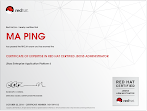运行环境:JBoss Data Grid 6.3.0
Hello World 只能运行在Library mode下。
学习重点:
1. 如何从Servlet访问Cache ?
使用CDI依赖注入到Servlet中。
@Inject
DefaultCacheManager m;
2. 如何从JSF页面访问Cache ?
使用CDI依赖注入到Managed Bean中,然后JSF通过Managed Bean访问Cache。
@Inject
DefaultCacheManager m;
3. 如何设置DefaultCacheManager ?
@ApplicationScoped
public class MyCacheManagerProvider {
private static final long ENTRY_LIFESPAN = 60 * 1000; // 60 seconds
@Inject
private Logger log;
private DefaultCacheManager manager;
public DefaultCacheManager getCacheManager() {
if (manager == null) {
log.info("\n\n DefaultCacheManager does not exist - constructing a new one\n\n");
GlobalConfiguration glob = new GlobalConfigurationBuilder().clusteredDefault() // Builds a default clustered configuration
.transport().addProperty("configurationFile", "jgroups-udp.xml") // provide a specific JGroups configuration
.globalJmxStatistics().allowDuplicateDomains(true).enable() // This method enables the jmx statistics of the global configuration and allows for duplicate JMX domains
.build(); // Builds the GlobalConfiguration object
Configuration loc = new ConfigurationBuilder().jmxStatistics().enable() // Enable JMX statistics
.clustering().cacheMode(CacheMode.DIST_SYNC) // Set Cache mode to DISTRIBUTED with SYNCHRONOUS replication
.hash().numOwners(2) // Keeps two copies of each key/value pair
.expiration().lifespan(ENTRY_LIFESPAN) // Set expiration - cache entries expire after some time (given by the lifespan parameter) and are removed from the cache (cluster-wide).
.build();
manager = new DefaultCacheManager(glob, loc, true);
}
return manager;
}
@PreDestroy
public void cleanUp() {
manager.stop();
manager = null;
}
}
注意,这里的配置使用了集群方式。
4. 在Servlet和Managed Bean中依赖注入的 DefaultCacheManage 是如何与 MyCacheManagerProvider关联的?
public class Resources {
@Inject
MyCacheManagerProvider cacheManagerProvider;
@Produces
Logger getLogger(InjectionPoint ip) {
String category = ip.getMember().getDeclaringClass().getName();
return Logger.getLogger(category);
}
@Produces
DefaultCacheManager getDefaultCacheManager() {
return cacheManagerProvider.getCacheManager();
}
}
这里使用了@Produces,为各种资源“注入”了Logger和DefaultCacheManager对象。
5. 启动JBoss EAP 6.3
(1)启动JBoss EAP Server1
cd /Users/maping/Redhat/Eap/jboss-eap-6.3-jdg-helloworld-1/bin
./standalone.sh
(2)启动JBoss EAP Server 2
cd /Users/maping/Redhat/Eap/jboss-eap-6.3-jdg-helloworld-2/bin
./standalone.sh -Djboss.socket.binding.port-offset=100
6.编译和部署 jboss-helloworld-jdg.war到JBoss EAP Server1和Server2上。
7. 运行
(1)http://localhost:8080/jboss-helloworld-jdg
(2)http://localhost:8180/jboss-helloworld-jdg
无论在哪个Server上操作,另外一个Server上都能“看到”操作后的结果。
Hello World 只能运行在Library mode下。
学习重点:
1. 如何从Servlet访问Cache ?
使用CDI依赖注入到Servlet中。
@Inject
DefaultCacheManager m;
2. 如何从JSF页面访问Cache ?
使用CDI依赖注入到Managed Bean中,然后JSF通过Managed Bean访问Cache。
@Inject
DefaultCacheManager m;
3. 如何设置DefaultCacheManager ?
@ApplicationScoped
public class MyCacheManagerProvider {
private static final long ENTRY_LIFESPAN = 60 * 1000; // 60 seconds
@Inject
private Logger log;
private DefaultCacheManager manager;
public DefaultCacheManager getCacheManager() {
if (manager == null) {
log.info("\n\n DefaultCacheManager does not exist - constructing a new one\n\n");
GlobalConfiguration glob = new GlobalConfigurationBuilder().clusteredDefault() // Builds a default clustered configuration
.transport().addProperty("configurationFile", "jgroups-udp.xml") // provide a specific JGroups configuration
.globalJmxStatistics().allowDuplicateDomains(true).enable() // This method enables the jmx statistics of the global configuration and allows for duplicate JMX domains
.build(); // Builds the GlobalConfiguration object
Configuration loc = new ConfigurationBuilder().jmxStatistics().enable() // Enable JMX statistics
.clustering().cacheMode(CacheMode.DIST_SYNC) // Set Cache mode to DISTRIBUTED with SYNCHRONOUS replication
.hash().numOwners(2) // Keeps two copies of each key/value pair
.expiration().lifespan(ENTRY_LIFESPAN) // Set expiration - cache entries expire after some time (given by the lifespan parameter) and are removed from the cache (cluster-wide).
.build();
manager = new DefaultCacheManager(glob, loc, true);
}
return manager;
}
@PreDestroy
public void cleanUp() {
manager.stop();
manager = null;
}
}
注意,这里的配置使用了集群方式。
4. 在Servlet和Managed Bean中依赖注入的 DefaultCacheManage 是如何与 MyCacheManagerProvider关联的?
public class Resources {
@Inject
MyCacheManagerProvider cacheManagerProvider;
@Produces
Logger getLogger(InjectionPoint ip) {
String category = ip.getMember().getDeclaringClass().getName();
return Logger.getLogger(category);
}
@Produces
DefaultCacheManager getDefaultCacheManager() {
return cacheManagerProvider.getCacheManager();
}
}
这里使用了@Produces,为各种资源“注入”了Logger和DefaultCacheManager对象。
5. 启动JBoss EAP 6.3
(1)启动JBoss EAP Server1
cd /Users/maping/Redhat/Eap/jboss-eap-6.3-jdg-helloworld-1/bin
./standalone.sh
(2)启动JBoss EAP Server 2
cd /Users/maping/Redhat/Eap/jboss-eap-6.3-jdg-helloworld-2/bin
./standalone.sh -Djboss.socket.binding.port-offset=100
6.编译和部署 jboss-helloworld-jdg.war到JBoss EAP Server1和Server2上。
7. 运行
(1)http://localhost:8080/jboss-helloworld-jdg
(2)http://localhost:8180/jboss-helloworld-jdg
无论在哪个Server上操作,另外一个Server上都能“看到”操作后的结果。





没有评论:
发表评论